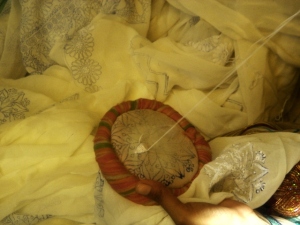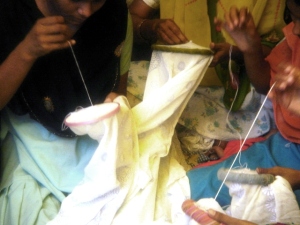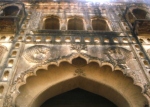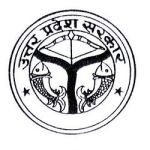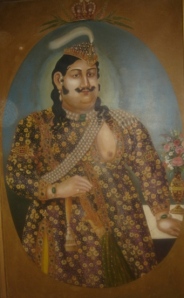Domes of Asafi Masjid at Bara ImamBara as seen from Teele waali masjid. Asafi ,as it was built by Asif ud Daula.
Teele Waali masjid stands next to Laal Pul(Red Bridge)on the banks of Gomti river.
The girl looking at you is Mushrat who is getting trained in the art of chikan kari under the expert eyes of her mother who is sitting besides her.
Chikan work is painstaking and tedious.Typically the girls will work for 6 hours every day for 26 days and they get paid just Rs 1000($25) for this.
A saree with intricate work on chiffon can take as many as 6 months to complete ! Several artisans work on the same piece day in and day out till it gets completed.I am sure that by the time its ready to be given back they form a kind of bond with the piece of clothing on which they have worked ceaselessly together.
The monotony of the job at hand is broken by friendly banter and chit chat among the women folk who will discuss their family woes and financials with their co workers.
Chewing Paan ( betel leaf and nuts) adds flavor and color to an otherwise dull scene.
The motifs are printed with Indigo blue so they can be washed off after the embroidery is done.They say that Chikan pieces face most testing conditions and travel from one place to another , much more than they would ever, once they are sold off.
Happiness is a state of mind for this poor Zardozi worker who takes pride in his work even though his remuneration is a pittance.
 The back side of Roomi Darwaaza.The Rumi Darwaza, which stands sixty feet tall, was modeled after the Sublime Porte (Bab-iHümayun) in Istanbul.Made by Asif ud daula it has now become an icon for Lucknow.
The back side of Roomi Darwaaza.The Rumi Darwaza, which stands sixty feet tall, was modeled after the Sublime Porte (Bab-iHümayun) in Istanbul.Made by Asif ud daula it has now become an icon for Lucknow.
Rumi gate as seen from Asafi mosque.The Rumi gate is named after Rumi the great Sufi saint of Turkey.The landscape around the gate was once very beautiful. In fact this was once the entrance to the walled city area of Lucknow. The gateway has been mentioned in various sources but the most famous one is considered to be the report published by one George Russell who worked as a reporter of The New York times in mid 19th century. Russell, who accompanied the victorious British Army in 1857 had called the stretch of road from Rumi Darwaza to Chattar Manzil the most beautiful and spectacular cityscape that he had ever seen, better than Rome, Paris, London or Constantinople.
That’s the Symbol of Oudh Kingdom which has now been adapted by the UP government as its official State Emblem.
Legend has it that during Akbar’s time Sheikh Abdur Rahim went to Delhi to seek his fortune.He returned to Lucknow as the Governor of Awadh and on his way back encountered the lucky sign of Mahi Muratib, while crossing the Ganges.Known as the Order of the Fish (“fish dignity” in Persian and Arabic), an honorary badge or dignity, shaped like a fish it is said to signify youth, bravery, perseverance and strength. Since then it was to be found on all great buildings and official documents as the royal insignia of the Nawabs of Awadh.
Second of the two gates which lead to Bara Imam bara.Notice the 4 balconies which are quite similar to those found at hawa mahal in Jaipur.
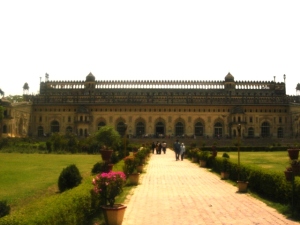 The front facade of Bara Imam bara built by Nawab Asif ud Daula who is buried here too.The design of the Imambara was obtained through a competitive process. The winner was an architect Kifayatullah, who also lies buried in the main hall of the Imambara. It is rather interesting that the sponsor and the architect lie buried besides each other.
The front facade of Bara Imam bara built by Nawab Asif ud Daula who is buried here too.The design of the Imambara was obtained through a competitive process. The winner was an architect Kifayatullah, who also lies buried in the main hall of the Imambara. It is rather interesting that the sponsor and the architect lie buried besides each other.
The building was instituted to provide work to the famine stricken subjects of the Nawab.It is said that in day time ordinary people would construct the building and in the night kings and Noblemen would demolish the structure.
During this time the saying became famous :
जिसको ना दे मौला उसको दे आसिफ उद दौला
( whom the Gods don’t provide for is looked after by Asif ud Daula)
When courtiers brought this to the notice of Asif-ud-Daula, he was not very exactly pleased. His take was :
” आप मुझे मेरे मौला से ऊपर का दर्ज़ा नहीं दे सकते.ये गलत है.करनेवाला तो खुदा है, इंसान तो बस एक ज़रिया है.गर केहना ही है तो कहिये : जिसको दे मौला , उसी को दे असिफुद दौला (Asifud Daula provides for those whom the God looks after)”
The Hussainabad Clock Tower, the tallest Clock Tower in India, is one of the finest examples of British Architecture in India. The 221-foot tall structure was erected by Nawab Nasir-ud-din Haider to mark the arrival of Sir George Couper, 1st Lieutenant Governor of United Province of Avadh in the year 1887 at a cost of Rs. 1.75 lakhs. The contract for constructing the clock tower was given to James William Benson, the royal clock maker in England who made clocks for the queen of England.
The Clock Tower in Lucknow reaches upto a staggering height of 221 feet and is the tallest Clock Tower in India. The Clock tower also has the biggest fitted clock . Roskell Payne designed this lofty structure of 67 meter high and it reflects Victorian-Gothic style structural designs. Gunmetal is used for building the clock parts. It’s gigantic pendulum has a length of 14 feet and the dial of the clock is designed in the shape of a 12-petalled flower and bells around it. Sadly the clock has been dysfunctional for decades now.
Notice the Swan Bird at the very top which was probably a weathervane and gave the direction of the wind. Recently the head fell off and it is said to have weighed 13 Kgs !!
On a clear day one can see the city of Cawnpore (Kanpur)from atop of this tower !!
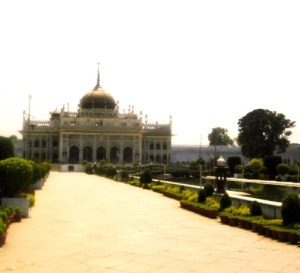 The Chotta Imam baara was a place of worship for the begums who resided in the near by Chattar Manzil palace.As you enter from the elaborate gate there is the Shahi Hammam where the begums performed Wuzoo ( cleansing before namaz).The Water came through pipes from Gomti River to the Husainabad Tank from where it was fed to different areas of the royal residence.
The Chotta Imam baara was a place of worship for the begums who resided in the near by Chattar Manzil palace.As you enter from the elaborate gate there is the Shahi Hammam where the begums performed Wuzoo ( cleansing before namaz).The Water came through pipes from Gomti River to the Husainabad Tank from where it was fed to different areas of the royal residence.
 If you are wondering about the Chain in the hands of this statuette ,its for conducting electricity in case of a weather storm so the buildings are safe.
If you are wondering about the Chain in the hands of this statuette ,its for conducting electricity in case of a weather storm so the buildings are safe.
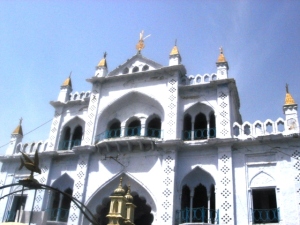 The gate of Chotta Imam Bara.Notice the Anglo Gothic and Turkish design elements in its architecture.The arches are Turkish as found in the Taj Mahal and the Spires are Gothic as you would see in churches.
The gate of Chotta Imam Bara.Notice the Anglo Gothic and Turkish design elements in its architecture.The arches are Turkish as found in the Taj Mahal and the Spires are Gothic as you would see in churches.
 The Husainabad pond.It is said that when cornered by the british forces Sultana Daaku(bandit) jumped from the 67 meter high clock tower into this pond and escaped.My guide told me that these were stories concocted by the servants of the Noblemen to put the kids to sleep.Another version holds that he jumped straight away to his horseback from the top of the tower and escaped.I believe in both of them !
The Husainabad pond.It is said that when cornered by the british forces Sultana Daaku(bandit) jumped from the 67 meter high clock tower into this pond and escaped.My guide told me that these were stories concocted by the servants of the Noblemen to put the kids to sleep.Another version holds that he jumped straight away to his horseback from the top of the tower and escaped.I believe in both of them !
Wajid Ali Shah..the grandest of the Nawabs of Oudh.Known for his interest in fine arts he was himself a great poet and composer.Here are the lyrics of his famous thumri composed in raag Bhairavi:
बाबुल मोरा, नैहर छूटो ही जाए
बाबुल मोरा, नैहर छूटो ही जाए
चार कहार मिल, मोरी डोलिया सजावें (उठायें)
मोरा अपना बेगाना छूटो जाए | बाबुल मोरा …
आँगना तो पर्बत भयो और देहरी भयी बिदेश
जाए बाबुल घर आपनो मैं चली पीया के देश | बाबुल मोरा …
It was predicted that he would become a jogi and his poetry deeply reflects this state of mind.Another one of my favorite from Shatranj ke Khiladi :
तरप तरप सगरी रैन गुजरी , कौन देस गयो सांवरिया
भर आयीं अंखियां मदवारी , तरस तरस गयी चुनरिया ,
तुम्हरे घोडन मोरे द्वार से जो निकसे ,सुध भूल गयी मैं बांवरिया
तरप तरप सगरी रैन गुजरी , कौन देस गयो सांवरिया….
Another gem that he recited to his friends and followers at the time of leaving Lucknow for Metia Burj in Calcutta :
दरो दीवार पे हसरत से नज़र करते हैं , खुश रहो अहले वतन हम तो सफर करते हैं
With a yearning gaze I look at the doors and the wall
I have to leave now but may God bless you all….
Noted Columnist Amaresh Mishra writes –
Wajid Ali Shah was an unusual man of an unusual time – when everything was possible he did the impossible.He preserved for posterity what it meant to be a true Asian in th best and worst of periods.Beneath the rapidly spreading tentacles of Western might and culture he upturned the very meaning of tradition to create a concept of Asiatic freedom.This was freedom that followed the mind and the heart according to the need of the situation.It did not take anything for granted believing in transitory nature of all phenomena.And yet it captured every moment in its entirety.
Wajid Ali Shah, in this form and content , was the greatest enemy of the British.He was the exact opposite of their puritanical,positivist, pugnacious and metaphysical value system.When they called him indolent , he involved the people in his sensual pleasures.When they termed in capricious,he shamed the British with his Humanism.Charged with over indulgence he institutionalized his love for Music,dance and Women.( The Parikhana was a hostel for girls training in Music and Dance)
The below conversation between Resident Outram and Captain Weston gives us a flavor of the paradox Wajid Ali Shah was.Not only his friends but his enemies too liked him.
Wajid Ali Shah gave Kathak its present form,invented several new ragas,wrote and composed Khayals and Thumris which his subjects embraced as their own and sang them in the streets of Lucknow.
He also invented Rahas a blend of Urdu and Raas Lila of Brij which became the basis of the Ganga Jamuni tehzeeb.During his time the Hindus and Muslims blended together as One and it would have been difficult to convince either of them of a different way of life.
When his Mother the Queen of Awadh left for London to plead with the Queen of England to give his Masnad back, the streets and lanes of Awadh cheered and prayed for their Jan e Alam ( one who is loved by the whole world) :
हज़रत जाते हैं लन्दन , हम पर क्रुपा करो रघुनन्दन
( Our king is going to London,Help us O lord Rama)
The socio cultural fabric had Hindus and Muslims as its warp and weft interwoven in a manner that the hues of differentiation simply diffused to create something wondrous and Joyful.Holi and Diwali were Occasions of celebration and so was Id.Muslims composed Bhajans and Geets while Hindus wrote Ghazals and Nazms , quality and Bhaav being the only creteria.Same was the case of trade and commerce – Brahmins made sweets as they were good at it and making Itr was a Muslim domain as they did it better.Pandit and Maulvi engaged in debates on Ethics and religion not in a duel for one upmanship but to understand the true nature of creation and the beings in it.
Chattar Manzil palace by the banks of Gomti river which used to the abode of the Queens of the nawabs of Oudh.It now houses the prestigious Central Drug research institute which was inaugurated by PM Jawahar Lal Nehru in 1951 to pioneer drug research in India.
The famous Begum Hazrat Mahal resided at Chattar Manzil Palace and led the revolt against the British from here by appointing her 10 year old son as the Monarch.Her tomb is still there at Begum Hazrat Mahal Park which is home to many an event especially the Lucknow Mahotsav which has now moved Venue to a place outside the city.
I am sorry for not being able to capture many other monuments of this great city and also for the random nature of narration.You may enjoy being an aimless wanderer as much as I have while taking pictures and talking to folks on the city streets.
** All Pictures from my SONY cyber Shot



